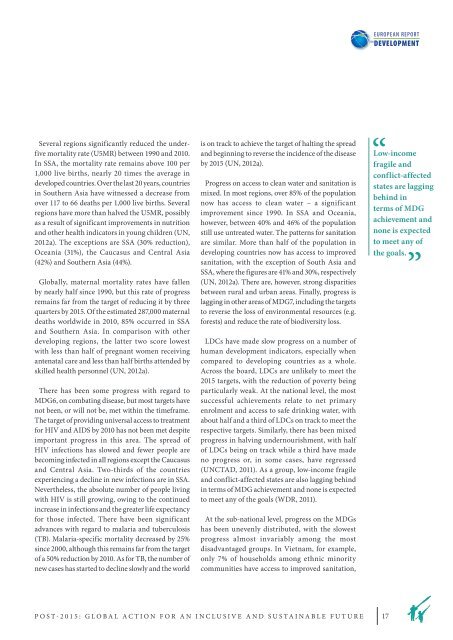Post 2015: Global Action for an Inclusive and Sustainable Future
Post 2015: Global Action for an Inclusive and Sustainable Future
Post 2015: Global Action for an Inclusive and Sustainable Future
You also want an ePaper? Increase the reach of your titles
YUMPU automatically turns print PDFs into web optimized ePapers that Google loves.
Several regions signific<strong>an</strong>tly reduced the underfive<br />
mortality rate (u5mr) between 1990 <strong>an</strong>d 2010.<br />
In SSa, the mortality rate remains above 100 per<br />
1,000 live births, nearly 20 times the average in<br />
developed countries. over the last 20 years, countries<br />
in Southern asia have witnessed a decrease from<br />
over 117 to 66 deaths per 1,000 live births. Several<br />
regions have more th<strong>an</strong> halved the u5mr, possibly<br />
as a result of signific<strong>an</strong>t improvements in nutrition<br />
<strong>an</strong>d other health indicators in young children (un,<br />
2012a). the exceptions are SSa (30% reduction),<br />
oce<strong>an</strong>ia (31%), the caucasus <strong>an</strong>d central asia<br />
(42%) <strong>an</strong>d Southern asia (44%).<br />
<strong>Global</strong>ly, maternal mortality rates have fallen<br />
by nearly half since 1990, but this rate of progress<br />
remains far from the target of reducing it by three<br />
quarters by <strong>2015</strong>. of the estimated 287,000 maternal<br />
deaths worldwide in 2010, 85% occurred in SSa<br />
<strong>an</strong>d Southern asia. In comparison with other<br />
developing regions, the latter two score lowest<br />
with less th<strong>an</strong> half of pregn<strong>an</strong>t women receiving<br />
<strong>an</strong>tenatal care <strong>an</strong>d less th<strong>an</strong> half births attended by<br />
skilled health personnel (un, 2012a).<br />
there has been some progress with regard to<br />
mDG6, on combating disease, but most targets have<br />
not been, or will not be, met within the timeframe.<br />
the target of providing universal access to treatment<br />
<strong>for</strong> HIv <strong>an</strong>d aIDS by 2010 has not been met despite<br />
import<strong>an</strong>t progress in this area. the spread of<br />
HIv infections has slowed <strong>an</strong>d fewer people are<br />
becoming infected in all regions except the caucasus<br />
<strong>an</strong>d central asia. two-thirds of the countries<br />
experiencing a decline in new infections are in SSa.<br />
nevertheless, the absolute number of people living<br />
with HIv is still growing, owing to the continued<br />
increase in infections <strong>an</strong>d the greater life expect<strong>an</strong>cy<br />
<strong>for</strong> those infected. there have been signific<strong>an</strong>t<br />
adv<strong>an</strong>ces with regard to malaria <strong>an</strong>d tuberculosis<br />
(tb). malaria-specific mortality decreased by 25%<br />
since 2000, although this remains far from the target<br />
of a 50% reduction by 2010. as <strong>for</strong> tb, the number of<br />
new cases has started to decline slowly <strong>an</strong>d the world<br />
is on track to achieve the target of halting the spread<br />
<strong>an</strong>d beginning to reverse the incidence of the disease<br />
by <strong>2015</strong> (un, 2012a).<br />
progress on access to cle<strong>an</strong> water <strong>an</strong>d s<strong>an</strong>itation is<br />
mixed. In most regions, over 85% of the population<br />
now has access to cle<strong>an</strong> water – a signific<strong>an</strong>t<br />
improvement since 1990. In SSa <strong>an</strong>d oce<strong>an</strong>ia,<br />
however, between 40% <strong>an</strong>d 46% of the population<br />
still use untreated water. the patterns <strong>for</strong> s<strong>an</strong>itation<br />
are similar. more th<strong>an</strong> half of the population in<br />
developing countries now has access to improved<br />
s<strong>an</strong>itation, with the exception of South asia <strong>an</strong>d<br />
SSa, where the figures are 41% <strong>an</strong>d 30%, respectively<br />
(un, 2012a). there are, however, strong disparities<br />
between rural <strong>an</strong>d urb<strong>an</strong> areas. Finally, progress is<br />
lagging in other areas of mDG7, including the targets<br />
to reverse the loss of environmental resources (e.g.<br />
<strong>for</strong>ests) <strong>an</strong>d reduce the rate of biodiversity loss.<br />
lDcs have made slow progress on a number of<br />
hum<strong>an</strong> development indicators, especially when<br />
compared to developing countries as a whole.<br />
across the board, lDcs are unlikely to meet the<br />
<strong>2015</strong> targets, with the reduction of poverty being<br />
particularly weak. at the national level, the most<br />
successful achievements relate to net primary<br />
enrolment <strong>an</strong>d access to safe drinking water, with<br />
about half <strong>an</strong>d a third of lDcs on track to meet the<br />
respective targets. Similarly, there has been mixed<br />
progress in halving undernourishment, with half<br />
of lDcs being on track while a third have made<br />
no progress or, in some cases, have regressed<br />
(unctaD, 2011). as a group, low-income fragile<br />
<strong>an</strong>d conflict-affected states are also lagging behind<br />
in terms of mDG achievement <strong>an</strong>d none is expected<br />
to meet <strong>an</strong>y of the goals (WDr, 2011).<br />
at the sub-national level, progress on the mDGs<br />
has been unevenly distributed, with the slowest<br />
progress almost invariably among the most<br />
disadv<strong>an</strong>taged groups. In vietnam, <strong>for</strong> example,<br />
only 7% of households among ethnic minority<br />
communities have access to improved s<strong>an</strong>itation,<br />
poSt-<strong>2015</strong>: <strong>Global</strong> actIon For <strong>an</strong> IncluSIvE <strong>an</strong>D SuStaInablE FuturE<br />
Low-income<br />
fragile <strong>an</strong>d<br />
conflict-affected<br />
states are lagging<br />
behind in<br />
terms of MDG<br />
achievement <strong>an</strong>d<br />
none is expected<br />
to meet <strong>an</strong>y of<br />
the goals.<br />
17

















